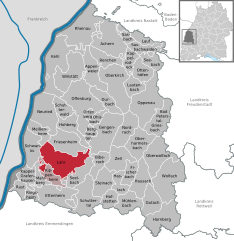Lahr | |
|---|---|
 General view of Lahr | |
Location of Lahr within Ortenau district  | |
| Coordinates: 48°20′N 7°52′E / 48.333°N 7.867°E | |
| Country | Germany |
| State | Baden-Württemberg |
| Admin. region | Freiburg |
| District | Ortenau |
| Founded | 1278 |
| Subdivisions | 7 boroughs |
| Government | |
| • Lord mayor (2019–27) | Markus Ibert[1] (Ind.) |
| Area | |
• Total | 69.86 km2 (26.97 sq mi) |
| Elevation | 170 m (560 ft) |
| Population (2022-12-31)[2] | |
• Total | 49,074 |
| • Density | 700/km2 (1,800/sq mi) |
| Time zone | UTC+01:00 (CET) |
| • Summer (DST) | UTC+02:00 (CEST) |
| Postal codes | 77901–77933 |
| Dialling codes | 07821 |
| Vehicle registration | OG, BH, KEL, LR, WOL |
| Website | www.lahr.de |
Lahr (officially Lahr/Schwarzwald since 30 September 1978) (German: [laːɐ̯]); Low Alemannic: Lohr) is a city in western Baden-Württemberg, Germany, approximately 50 km north of Freiburg im Breisgau, 40 km southeast of Strasbourg, and 95 km southwest of Karlsruhe. It is the second largest city in Ortenau (district) after Offenburg, and serves as an intermediate economic centre for the cities and towns of Ettenheim, Friesenheim, Kappel-Grafenhausen, Kippenheim, Mahlberg, Meißenheim, Ringsheim, Rust, Schuttertal, Schwanau and Seelbach.
The population of Lahr passed the 20,000 mark in the mid-1950s. When the new body of Municipal Law for Baden-Württemberg came into effect on April 1, 1956, the city was therefore immediately accorded Große Kreisstadt status. In addition, Lahr cooperates with the town of Kippenheim in administrative matters.
- ^ Aktuelle Wahlergebnisse, Staatsanzeiger, accessed 13 September 2021.
- ^ "Bevölkerung nach Nationalität und Geschlecht am 31. Dezember 2022" [Population by nationality and sex as of December 31, 2022] (CSV) (in German). Statistisches Landesamt Baden-Württemberg. June 2023.


